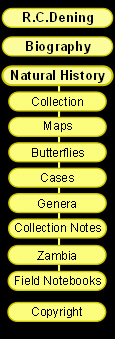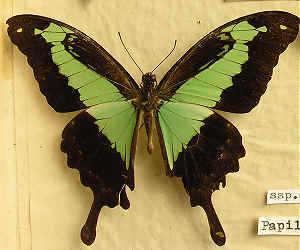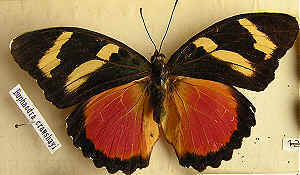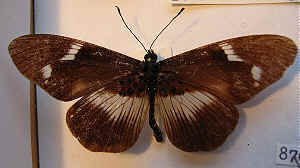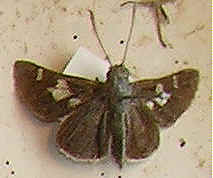The R.C. Dening Collection |
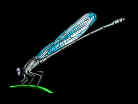 |
Introduction to Zambian Butterflies
by R.C. Dening F.R.E.S.
Species and Habitats - continued
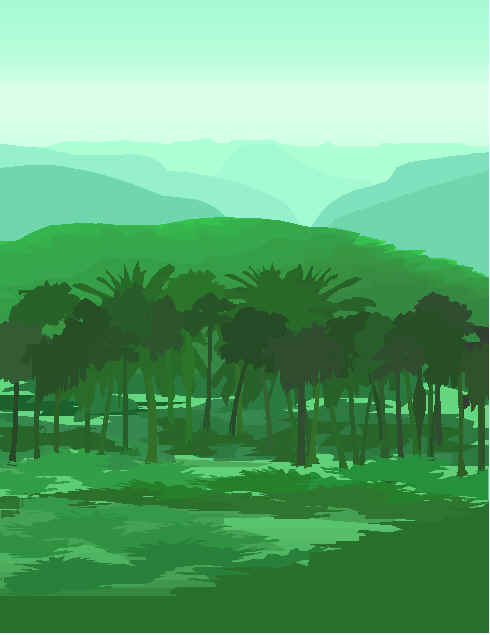 |
DISTRIBUTION WITHIN THE RAINFOREST BIOME |
| This biome
contrasts strongly with the surrounding deciduous or semi-deciduous forests that cover
much of Zambia. In general, it infiltrates from the main Congo rainforest zone across the
north of the country, in the form of riverine, evergreen wet forest, extending in some
places to swamp forest and somewhat larger evergreen stands. These forests have two main effects on the butterfly fauna. They provide specialised microclimates and a different range of hostplants. Thus species which require the deep shade of the forest floor proliferate in the forests near Kalene Hill, in the extreme northwest, while plant families such as Lauraceae are hosts for such species as Papilio hesperus. Riverine evergreen habitats also exist to a limited extent in other parts of the country, where butterfly species occur which prefer evergreen hostplants not normally found in savanna habitats. For instance, the preference of Charaxes brutus is for the family Meliaceae, predominantly evergreen species associated with fringing forest. It also occurs where these species have been planted as shade trees, as in the centre of Lusaka, where population explosions are sometimes observed on the Trichilia emetica trees in Cairo Road, with larvae and pupae scattered on the public benches.In many of the northern riverine habitats, the occurrence of rainforest fauna is patchy, with no great numbers of different species in any one place. Thus along a small, shady stream, one may see the White Banded Swallowtail Papilio echerioides homeyeri, the small riodinin Abisara rogersi and possibly the Euthaline forest floor species Aterica galene and Catuna crithea pallidior. One or more spectacular Charaxes may also occur, such as C.murphyi on the South Mutundu River near Mufulira, or C.eudoxus mitchelli in small patches of wet forest at Lake Kashiba (Mpongwe) near Ndola or again at the South Mutundu River, albeit rarely. Wet, thickly forested places at the sources of streams may also contain unusual species. Thus the source of the Zambezi, some miles north of the Mwinilunga–Ikelenge road, is home to deep shade species of the forest floor, such as Bicyclus sebetus, B.trilophus and B.sophrosyne overlaeti. It has also provided the only confirmed Zambian record of Charaxes acuminatus cottrelli. Not far away, near the Ken Suckling Mission on the Luakela River, in April 1988, Blease found the only known Zambian colony of the African Leaf Butterfly Kamilla ansorgei.Similar habitats occur in the northern Luapula Province, for instance along the Kalungwishi River, and in Northern Province, where they have become known in association with popular waterfalls. Here Bicyclus sebetus also occurs, together with unusual Charaxes, such as C.lucretius schofieldi and C.eudoxus zambiae. Of all these habitats, the most notable is the Isombo and Mudileji cluster of streams to the west of Kalene Hill in northwest Mwinilunga. They flow into the Zambezi inside Angola, and are unconnected to the Congo rainforest to the north. They appear to represent a relict fauna from the past pluvial period.First noted in 1954, these relatively small evergreen areas had been undisturbed throughout the colonial period, due to their proximity to the Angolan border; by mutual agreement people could pass through them, but not settle within them. They survived intact until the 1970's, but their status today is not clear, due to pressure from an influx of refugees. It has been reported that the Isombo forest itself has been cut down to make way for cassava fields. Thus an appreciable number of species in the list may have ceased to occur within Zambia. On the other hand, they may still survive in other relict patches in the same neighbourhood.
Among the Pierids is the delicate, translucent-winged Pseudopontia paradoxa in its own monotypic subfamily, and two wet forest Leptosia spp., L.hybrida vansomereni and L.nupta. The acraeine genus Bematistes of large forest species is represented by B.epaea, B.macarista and B.umbra macaroides, while common danaines are Amauris niavius and A.tartarea. In deep shade occur the satyrines Gnophodes betsimena parmeno and the previously mentioned Bicyclus species, plus B.mesogena, B.mandanes and B.dubia.There are many more spectacular Nymphalidae, represented by Lachnoptera anticlea; Kamilla cymodoce; several forest Neptis spp. (e.g. N.nemetes, N.nicoteles), and the common Pseudoneptis bugandensis ianthe. The splendid scarlet male of Cymothoe sangaris luluana may with luck be seen after the rains, or C.herminia katshokwe in deep shade. These are matched by large Pseudacraeas, such as P.kuenowi, P.boisduvali, P.lucretia protracta and the smaller green spotted P.semire. Three forest floor Euriphenes (E.pallidior, E.incerta theodota and E.saphirina trioculata) may sometimes be found in numbers, flying alongside Catuna crithea pallidior and Aterica galene.
Notable Lycaenids fluttering in the shade are the white Oboronia guessfeldti and the delicate hairstreak Oxylides faunus. Flying along the streams, the very large hesperiid Gamia shelleyi may be seen, while in July, well into the dry season, the rare Artitropa cama appears. However, the most spectacular species of all are the rainforest Charaxes of the Tiridates group, notably C.numenes aequatorialis, C.tiridates tiridatinus, C.imperialis lisomboensis, C.ameliae amelina and C.pythodoris. Rainforest Charaxes of other groups include C.eudoxus (which occurs in Zambia as three subspecies), C.lucretius (in two subspecies), C.anticlea proadusta, C.hildebranti katangensis, and the black Charaxes etheocles carpenteri and C.cedreatis. While virtually all of these species are found in the strips of evergreen forest in the Kalene Hill pedicle, many also occur in other forest patches across the north of Zambia. But the question arises as to why these other forest patches are so much less species rich. Williamson, in an orchid study, has drawn attention to the occurrence of periodic natural disasters (Williamson,1982)In May 1968, the worst frost in living memory blanketed the whole country. In some upland woodlands, an estimated 20% of the epiphytes were destroyed; at Solwezi hoar-frost on the trees gave the impression of a light snowfall, destroying almost all the mosses and lichens and taking a very heavy toll of orchid species. Some relict riparian forests were severely affected, even in Mwinilunga District where frost is very infrequent. North of Mwinilunga on the Luakela River, some trees died, creating large gaps in the riparian forest and subsequent breaking up of the river bank. In the Northern Province, Raphia palms in the centre of seepages were badly damaged or destroyed. The riparian forest above Kundalila Falls was severely affected, causing an estimated loss of up to 20% of the epiphytes. In 1977,an unusually high flood swept away the complete relict forest above the Falls. An interesting observation is that the gallery forest at the Zambezi Rapids near Kalene Hill has not been adversely affected in recent times by flooding or frost.In 1971/72, a severe drought was experienced over the whole country except in Mwinilunga District. This drought caused many relict seepages to dry up. Fires were more severe than usual, causing complete destruction of some bogs. Thus it seems likely that the periodic incidence of frost, drought and flooding has limited the occurrence of sensitive butterfly species to a small number of well-favoured evergreen forest localities. But slow re-establishment into damaged localities is likely to occur between disaster incidents, as we have seen with Kamilla ansorgei on the Luakela River.
|
 |
THE AFRO-ALPINE BIOME |
| This biome is
confined to small high altitude areas in the northeast of Zambia. The best known is a
small part of Malawi's Nyika Plateau, which extends into Zambia. Also included are the
tops of the Mafinga and Makutu Mts. The Nyika element comprises the small Chowo forest at the headwaters of a stream, together with associated montane grassland. The altitude of this montane forest is around 2 000 metres. It is a National Park. A book at the Rest House, in which entomologists have recorded their captures, has provided a comprehensive list of the fauna. Other patches of montane forest occur at similar altitudes in the Mafinga and Makutu Mountains. As with the patches of rainforest across northern Zambia, the butterfly fauna of these areas is substantially different to that of the surrounding savanna. The Papilionidae are well represented in these montane areas. Common savanna species occur, such as P.demodocus and Graphium angolanus, as also species from the wetter savanna areas, such as P.ophidicephalus, P.dardanus tibullus and Graphium policenes, though not in any great numbers. Some rainforest species are represented by a montane subspecies, such as P.mackinnoni isokae and P.phorcas nyikanus. Exclusively montane species are the green-banded P.thuraui cyclopis, the white-banded P.jacksoni nyika and the large Lauraceae feeding P.pelodurus vesper.Pierids on the other hand are poorly represented. Five widespread savanna species are to be found: Catopsilia florella, Colias electo hecate, Nepheronia argia mhondana, Eurema brigitta and Mylothris rueppellii. Another Eurema, E.mandarinula, is found in Zambia only in the montane grasslands, while Mylothris crawshayi and M.sagala dentatus are associated with the montane forests. The wealth of Acraeine species in the savanna areas of Zambia is not reflected at the higher altitudes, only nine species normally being seen on the Nyika. Of these, three are common savanna species: Acraea natalica, A eponina and A.ventura, the two latter being associated with damp grasslands. A.parei orangica, in the anacreon group and only found on the Nyika, is the main grassland species, sometimes occurring in great numbers. The small A.goetzei and the delicate polymorphic A.acuta are found mainly near the forest edges. More closely associated with the forest are the larger transparent-forewinged A.baxteri on the Nyika, and A.insignis on the Mafingas, both rarely seen.
The Danainae are represented by the ubiquitous Danaus chrysippus and two Amauris species, A.echeria serica and A.ellioti junia, both subspecies of otherwise widespread taxa in Afro-montane habitats. A.niavius occurs in the Mafinga Mts., as subspecies dominicanus rather than the subspecies niavius of the evergreen forests of northern Zambia. Surprisingly, a single specimen of Tirumula formosa has been recorded from the Mafinga Mts. The Satyrinae are poorly represented. The almost universal palaeotropical Melanitis leda occurs even at the altitude of Chowo forest. Otherwise three montane species occur: Aphysoneura pigmentaria, in association with Arundinaria and various grasses, and Bicyclus simulacris and Henotesia ubenica in more open areas. Only eight representatives of the subfamily Nymphalinae have been commonly recorded. Four are palaeotropical migrants; Hypolimnas misippus, Cynthia cardui, Junonia orithya and J.hierta. The common savanna species J.octavia and J.artaxia also occur. Two temperate Afro-montane Admirals, Antanartia schaenia dubia and A.dimorphica are found at the forest edges.Of the ten Limenitine species, Eurytela hiarbas lita is an Afro-montane representative from more temperate regions to the south, while the woodland Eurytela dryope also occurs occasionally. The almost ubiquitous Byblia anvatara acheloia is found along forest edges. Four Neptis species have been recorded, the widespread N.laeta and the small N.nina (Makutu and Mafinga Mts. only), while the commonest species is the Afro-montane N.aurivillii, and the rarest, the very similar N.incongrua. Both of the latter prefer deep shade. There is a montane white-banded Cymothoe, C.cottrelli, a deep shade species, and two Pseudacraeas, the widespread woodland P.lucretia expansa and the unusual P.deludens. The latter mimics the aforementioned Amauris echeria serica, and also prefers shade. The only record for the tribe Euthaliini is of Bebearia orientis in May 1973. Finally, the subfamily Charaxinae is represented by at least nine common savanna species: C.varanes vologeses, C.candiope, C.jasius saturnus, C.brutus, C.pollux geminus, C.druceanus proximans, C.achaemenes and C.guderiana. Around bamboo thickets, C.macclounii is to be found. Four specifically montane species occur: C.acuminatus nyika, the large blue C.xiphares ludovici, the even rarer C.ansorgei levicki, and the black C.nyikensis. A further black montane species, C.aubyni australis, has been recorded from the Mafinga Mountains.Since most of the butterflies in the family Lycaenidae are associated with grassland, it is uncertain which of the many species recorded from the Malawi Nyika can be claimed for Zambia. Indeed, the Zambian border is not clearly defined across the grassland. One certain occurrence is the Small Copper, Lycaena phlaeas abbotti, which has been recorded in January, April and October. Lampides boeticus is common during the rains. Several Uranothauma species have been recorded, including U.crawshayi, U.cuneatum and U.williamsi. Other occurrences are Harpendyreus juno, Actizera stellata and Euchrysops malathana. Cottrell recorded Lepidochrysops nyika, L.pampolis and L.intermedia, mainly in November.
|
Continue to
